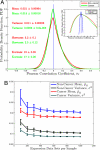Correlation signature of the macroscopic states of the gene regulatory network in cancer
- PMID: 19246374
- PMCID: PMC2657377
- DOI: 10.1073/pnas.0810803106
Correlation signature of the macroscopic states of the gene regulatory network in cancer
Abstract
Although cancer types differ substantially, many cancers share common gene expression signatures. Consistent with this observation, we find convergent and representative distributions and correlation vectors that are distinct in cancer and noncancer ensembles. These differences originate in many genes, but comparatively few genes account for the major differences. We identify genes with different combinatorial regulation in cancer and noncancer as indicated by significant differences in their correlation vectors. Among the identified genes are many established oncogenes and apoptotic genes (such as members of the Bcl-2, the MAPK, and the Ras families) and new candidate oncogenes. Our findings expand and complement the tumorigenic role of up and down regulation of these genes by emphasizing cancer-specific changes in their couplings and correlation patterns at genome-wide level that are independent from their mean levels of expression in cancer cells. Given the central role of these genes in defining the cancerous state it may be worth investigating them and the differences in their combinatorial regulation for developing wide-spectrum anticancer drugs.
Conflict of interest statement
The authors declare no conflict of interest.
Figures





References
-
- Getz G, Gal H, Kela I, Notterman DA, Domany E. Coupled two-way clustering analysis of breast cancer and colon cancer gene expression data. Bioinformatics. 2003;19:1079–1089. - PubMed
-
- Bild AH, et al. Oncogenic pathway signatures in human cancers as a guide to targeted therapies. Nature. 2006;439:353–357. - PubMed
-
- Godard S, et al. Classification of Human Astrocytic Gliomas on the Basis of Gene Expression: A Correlated Group of Genes with Angiogenic Activity Emerges As a Strong Predictor of Subtypes. Cancer Res. 2003;63:6613–6625. - PubMed
-
- Ross DT, et al. Systematic variation in gene expression patterns in human cancer cell lines. Nat Genet. 2000;24:227–235. - PubMed
Publication types
MeSH terms
LinkOut - more resources
Full Text Sources
Other Literature Sources

